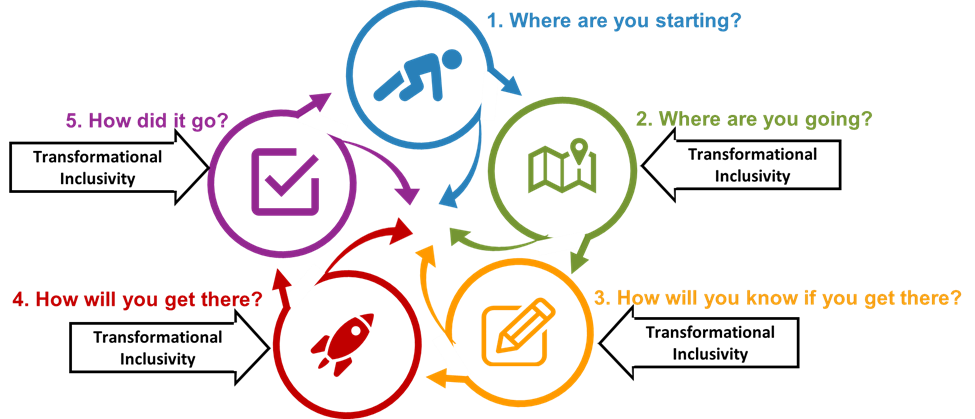
Unit A – Teaching & Learning Theories
A5. Transformative Inclusivity & Diversity
Transformative Inclusivity & Diversity
Inclusivity for Equal Access & for Transformative Learning Outcomes
Inclusive Course Outcomes for Equal Learning
As an instructor, you will want to create an inclusive environment for all your students to ensure they have equal learning experiences.
A multicultural diverse classroom is a conscious creation advocated and spearheaded by a teacher where … [the teacher] creates a bond and amiable inclusive atmosphere with acceptance and tolerance of diversity. … It can be seen as a classroom where the curriculum has elements of diversity and allow[s] students with exceptionalities to participate in the general education (Sengupta et al., 2019, p.6).
For details on student diversity, the importance of inclusivity, cultural differences, and actions for inclusive teaching and learning, see Chapter B4: Inclusivity & Diversity in the Classroom.
Inclusive Course Outcomes for Transformational Learning
In addition to providing an inclusive, welcoming class, you may also have transformational learning goals.
Consider an outcome to increase student awareness where:
Students would (a) critically analyze historical and contemporary examples of the group(s), (b) critically analyze the distribution of benefits and opportunities afforded these groups, (c) understand how the group(s) relate to the student’s discipline, and (d) demonstrate this understanding through written work (Gordon et al., 2019, p. 2).
Examples
- In her organic chemistry class, Nawarathne (2019, p. 2046) included a diversity assignment that:
“intentionally reinforce[d] student understanding of the versatility of carbon on the basis of its bonding and the prevalence of carbon-based molecules that we cannot live without. Students seemingly did not pause during their busy semesters to ponder these important factors before the diversity assignment; however, they made connections as they completed the assignment and participated in the related discussions…. The pre- and post-surveys conducted in 2018 clearly show that the diversity assignment improved students’ knowledge and awareness of versatile carbon bonding, molecular diversity, and social diversity”
- Sheridan Center for Teaching and Learning (2020) reports:
Brown faculty member Jeffrey Moser (History of Art and Architecture) includes a series of assignments in his Arts of Asia course (HIAA 21) that asks students to identify a piece of art that represents an artist, theme, community, or tradition they felt was missing from or underrepresented in the course and develop an argument about why it should be included. With each successive iteration of the course, Professor Moser then integrates at least one of these proposals into the syllabus and lecture (with acknowledgement of the student).
- Brown faculty member Robert Campbell’s (Molecular Pharmacology, Physiology and Biotechnology) syllabus on “Precision Medicine or Privileged Medicine?” includes the following:
By the end of this course, you should be able to:... Understand how non-inclusiveness of biomedical research may bias the distribution of benefits, harms and risks for people, stakeholders and communities. Analyze your assumptions and beliefs when working to facilitate civic engagement that makes a difference for people from other places and experiences. Recognize power imbalances and issues of trust that marginalize people from research. -BIOL-0940E (Robert Campbell, MPPB) (Sheridan Center for Teaching and Learning, 2020).
For other examples, see Office of Teaching Effectiveness and Innovation, Clemson University (n.d.)
IDI & Transformational Inclusivity Outcomes

The following actions are in addition to the actions listed under IDI & Inclusivity for Equal Access.
Step 2. Where are You Going?
2.1 Write Learning Outcomes & Objectives
- Include course outcomes and objectives targeted specifically at fostering equitable outcomes (Sheridan Center for Teaching and Learning, 2020).
- In course goals on diversity, include objectives on communicating with students from diverse backgrounds (Arkoudis et al., 2013, p.228)
Syllabus
- Please note that your organization may have a statement that must be included in your syllabus.
- Include outcomes and objectives related to inclusivity and learning communities (Arkoudis et al., 2013, p.228; Sheridan Center for Teaching and Learning, 2020). (Examples: Office of Teaching Effectiveness and Innovation, Clemson University, n.d.; Sheridan Center for Teaching and Learning, 2020).
- Also consider an outcome to increase student awareness where “students would (a) critically analyze historical and contemporary examples of the group(s), (b) critically analyze the distribution of benefits and opportunities afforded these groups, (c) understand how the group(s) relate to the student’s discipline, and (d) demonstrate this understanding through written work” (Gordon et al., 2019, p. 3).
- Include a statement about the value of diversity in groups (Arkoudis et al., 2013, p.230).
Step 3. How Will You Know If You Get There?
3.1 Develop Assessments & Rubrics
Assignment ideas to improve inclusivity
- Include “reflection through writing shared with classmates and writing that requires students to consider their own cultural histories and life experiences” (Smolcic & Arends, 2017, p.68).
- Design activities that “require students to engage with others from diverse backgrounds to gain information necessary for completing the tasks” such as expert interviews (Arkoudis et al., 2013, p.228).
- Include an assignment that requires students to reflect on the diversity in the class and their reaction to inclusive strategies (Arkoudis et al., 2013, p.231).
- Consider assignments which require the students to incorporate different cultural perspectives.
- Ask students to interview others (either other students or people not in class) who have different cultures/identify groups (Gordon et al., 2019, p. 6).
Group work
- Ask students to discuss their communication styles and how these can be used to strengthen the group. Smolcic & Arends (2017, p.68) report that although the students at first found it uncomfortable, matching international and national students in learning groups increased student introspection and awareness of their own and other cultural differences.
- Provide strategies for students to help overcome biases and microaggressions such as developing group rules, limiting talking time per person, breaking into smaller groups at points and coming back to the larger group with ideas, etc.
- When providing instructions on activities, discuss implicit bias that the activity may introduce and strategies for removing the bias (Sheridan Center for Teaching and Learning, 2020). For example, is it assumed that the female in the group will provide emotional support or take a serving role? Are students with heavy accents overtalked or ignored?
- Ask students to be aware of ‘tokenism’ – that is, watch for signs that a person is being asked to speak for their entire age, culture, race, religion, disability, etc.
- Ask students to pay attention to microaggressions within the group: These may include excluding students from discussions and activities, and stigmatizing students.
Step 4. How Will You Get There?
4.1 Develop & Teach Course
- When asking students to do research, also discuss with them the problems with browser algorithms (such as Google) which may provide racist, incorrect and/or slanted results (Noble, 2018). Ask students to report how algorithms have impacted their search results.
Content considerations for lectures and course readings
- When discussing pioneers in your field, discuss how, historically, international and diverse experts may have been ignored.
- Explicitly teach “cultural concepts, such as the liquid qualities of culture, the changing nature of cultural identities, cultural stereotypes and essentialized ideas of cultures, and globalization and its effects on culture (among others)” (Smolcic & Arends, 2017, p.68).
First Day
- Begin “with explicit statements about the diverse nature of topics discussed in the class and how there was an expectation of respect and consideration for all perspectives and experiences” (Booker & Campbell-Whatley, 2018, p.20).
Step 5. How Did It Go?
5.1 Evaluate Course Success
- Use the class outline to note how various activities worked.
References
Arkoudis, S., Watty, K., Baik, C., Yu, X., Borland, H., Chang, S., Lang, I., Lang, J., & Pearce, A. (2013). Finding common ground: Enhancing interaction between domestic and international students in higher education. Teaching in Higher Education, 18(3), 222–235. https://doi.org/10.1080/13562517.2012.719156.
Gordon, S. R., Yough, M., Finney, E. A., Haken, A., & Mathew, S. (2019). Learning about Diversity Issues: Examining the Relationship between University Initiatives and Faculty Practices in Preparing Global-Ready Students. Educational Considerations, 45(1). https://eric.ed.gov/?q=Diversity+in+the+classroom+better+student+learning&ff1=dtySince_2016&ff2=eduHigher+Education&pg=2&id=EJ1219107.
Nawarathne, I. N. (2019). Introducing Diversity through an Organic Approach. Journal of Chemical Education, 96(9), 2042–2049. https://doi.org/10.1021/acs.jchemed.8b00646.
Office of Teaching Effectiveness and Innovation, Clemson University. (n.d.). Diversity & Inclusion Syllabus Statements. Office of Teaching Effectiveness and Innovation, Clemson University. Retrieved September 30, 2020, from https://www.clemson.edu/otei/resources/review-of-teaching.html.
Sengupta, E., Blessinger, P., Hoffman, J., & Makhanya, M. (2019). Introduction to strategies for fostering inclusive classrooms in higher education. In Strategies for Fostering Inclusive Classrooms in Higher Education: International Perspectives on Equity and Inclusion. Emerald Publishing Limited. https://www.emerald.com/insight/content/doi/10.1108/S2055-364120190000016005/full/html.
Sheridan Center for Teaching and Learning. (2020). Effective Teaching Is Anti-Racist Teaching. Sheridan Center for Teaching and Learning, Brown University, 1812. https://www.brown.edu/sheridan/teaching-learning-resources/inclusive-teaching/effective-teaching-anti-racist-teaching.
Smolcic, E., & Arends, J. (2017). Building Teacher Interculturality: Student Partnerships in University Classrooms. Teacher Education Quarterly, 44(4), 51–73.
